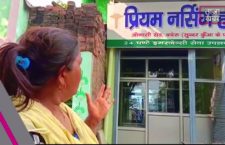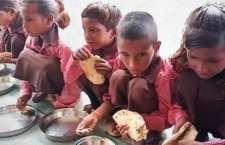Through the thick, humid months of July and August, an unverified clip raced across social media and WhatsApp accounts in northern India, featuring mutilated bodies and organs, purportedly part of an organ trade racket by child kidnappers.
When asked if there had been actual incidents of child-lifters visiting his village, Billu of Akbarpur village in Banda district of Uttar Pradesh said:“Yes, the other day someone came dressed as a woman in a hijab and was reportedly on the lookout for children, to commit all kinds of atrocities on them: stab their stomachs, pluck out their eyes, liver, hearts and whatnot. We don’t let children outside now, because of this fear.”
On being probed further on whether he had personally witnessed such an event he replied, “No, I have not seen it in person, but have seen a video on the mobile, where they show human bodies being cut. Of course, they don’t show any proof or the village and district where this is happening,” Billu seemed bemused that we could be this naive. His fairly simple logic was that if the people circulating these videos show proof, they would end up getting caught.
Like Billu, most of the rural populace in Bundelkhand believed this macabre content was credible. In a region where news reports and news consumption are dominated by incidents of violence, torture, and crime, this did not seem out of the ordinary and took no time in going viral across several districts. The atmosphere in Bundelkhand, a region mostly known for its agricultural distress, was tense, so much so that consoling a crying child on the streets was equal to asking for trouble.
Khabar Lahariya began a multi-district investigation into the spread of misinformation when the impact of these incidents became hard to ignore—with the old, mentally challenged or outsiders to a village being increasingly targeted, abused or beaten up, and children stopped from going to school. Besides personal and family groups, it was also widely shared across WhatsApp groups of local media agencies, which further stoked the fire.
On Aug. 22, a mentally challenged man was pinned down on his stomach outside Banda Medical College, his hands and legs tied up. The police were complicit in the cruelty—they repeatedly goaded him with water from a bottle as he lay helpless.
The pattern of mentally challenged or other marginalized persons as targets of collective rage and violence is a common one: In Chhatarpur district, an aged, homeless man was targeted by the public on the claim that he had been roaming the streets suspiciously. In Chitrakoot, a mentally challenged woman was arrested and locked up by the police, reportedly for trying to snatch away a girl from her mother near a bus stand. Local media, far from verifying and publishing a balanced report on this incident, attacked the woman with insensitive accusations, assuming her guilt.

The rash of rumors of child-napping and offline instances of violence over a six-week period found the police grappling for solutions.
Alok Mishra, the city area officer of Banda, backed up against a wall, made a face-saving and fairly weak attempt to stem the tide of violence: “There have been no real incidents of child kidnapping so far and all of them are just rumors. Whenever there have been complaints, we took quick action and found the incidents to be fake. I request people not to spread such rumors, but if they do feel there are some genuine incidents they can report directly to the police.”
The director-general of police of Uttar Pradesh, OP Singh had to intervene through a public video broadcast appealing to people to not take the law into their own hands.
He was referring to events not just in Bundelkhand but many other districts in Uttar Pradesh that had been equally affected—a rough estimate suggested that there were over 100 incidents of mob violence due to child lifting rumors, in the month of August alone in the state. These episodes—sweeping, hard-to-control and unfolding over months have become a regular phenomenon over the last few years and Uttar Pradesh has seen a striking increase over the last quarter.
Much has been reported on this phenomenon, but in the context of rural India, a few factors are noteworthy. One is high penetration of smartphones—one in three mobile owners in Uttar Pradesh use a smartphone and they make 15% of the total handset owners in the country as of 2018 and also a significant proportion of social media users.
The availability of cheap internet services after the launch of telecom service Jio has contributed in no small part to the traveling of mis/information at high speed. The rapid changes in digital infrastructure and networks come at the high cost of authenticity and quality of information being created and shared. This is against the backdrop of rising fear and distrust of some minority/marginalized communities, and the notion that there is a silent sanction to action by common citizens when they see lawlessness and insecurity in states like Uttar Pradesh.

According to data from IndiaSpend, there have been more than 33 cases of murder and over 99 cases of attacks triggered by rumors of child-lifting alone between 2017-18. Before 2017, only one incident was reported in 2012.
Most could be attributed to fake news spread through social media, especially WhatsApp.
While these may not establish direct linkages between social media and incidents of mob violence in general, it has aided the reach and speed of misinformation. A recent BBC report states that the information deluge through digital news has meant selective consumption of news where the lines between diverse sources are blurred and a preference for image and video content.

It also means that in the race for generating viral video content, local media may not necessarily authenticate facts and news in fact, as seen above, often contribute to the sensationalizing and spread of news reports with the potential of provoking a strong reaction.
When the rumors began in early August, many local channels corroborated people’s fears and contributed to the wildfire on local media WhatsApp groups. Tracking down the truth both online and offline is increasingly a dim and unrewarding prospect when people have already chosen what to believe in—as in our experience of covering this very story.
Two of our reporters, both women and from marginalized communities, were shooting a PTC outside a village where child lifting rumors had been flying high, in the midst of suspicious local onlookers. They were soon surrounded by a crowd armed with lathis whom they managed to pacify after much discussion.
This Khabar Lahariya, article first appeared in Quartz India
Reported by Meera Devi, Shyamkali, Suneeta Prajapati, Raj Kumari,Alima Trannum
Written by Nikita Joseph

